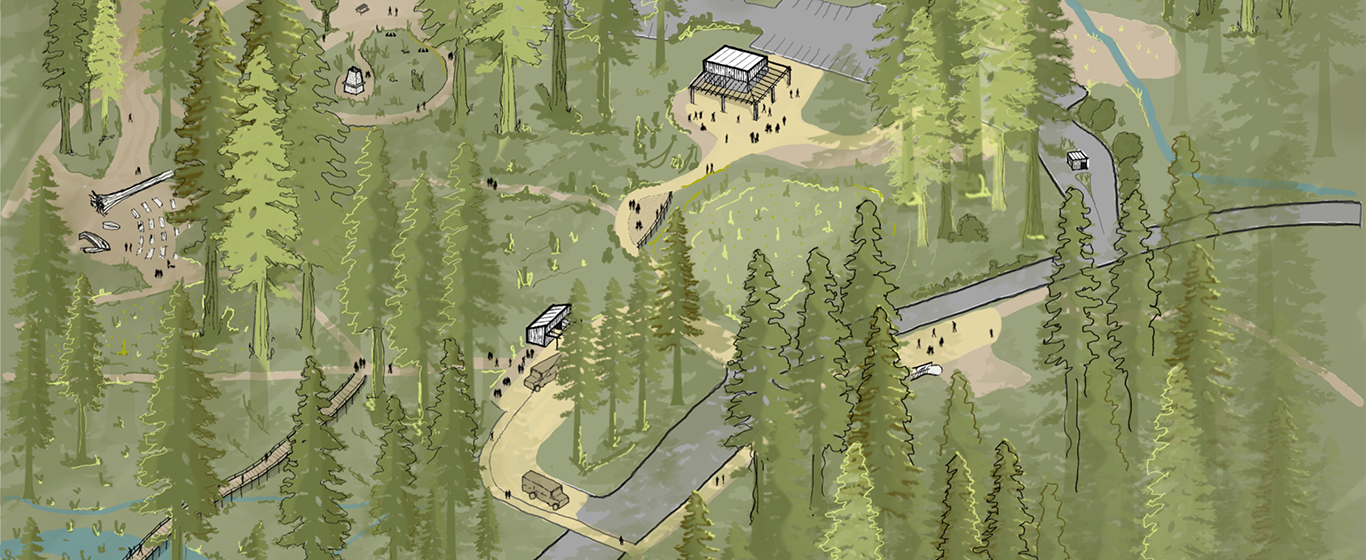
Beginning in Summer 2023, the Big Basin Redwoods State Park Facilities Management Plan (BBFMP) process will build upon the Reimagining Big Basin Visioning Process and will set the stage for the reestablishment of facilities to support visitor experiences and protect sensitive resources at Big Basin Redwoods State Park. The BBFMP planning process will be a multi-year effort concluding in 2025.
When planning for new or improved facilities, California State Parks can develop a Facilities Management Plan (FMP) to assess site opportunities and constraints, environmental considerations, and visitor experiences. An FMP document serves as a handbook and reference tool that makes recommendations about proposed facilities. It also helps streamline final design and environmental review for infrastructure and facility construction.
The BBFMP will include technical studies (utilities, engineering considerations, architectural concepts, natural and cultural resources protection, etc.) alongside a set of goals that are consistent with the Big Basin Redwoods State Park General Plan (2013), the Reimagining Big Basin Vision Summary (2022), and the California Environmental Quality Act (CEQA).
The BBFMP is intended to be utilized by California State Parks management, staff, park partners, and stakeholders. Restoration of public use areas will be explored in a series of Opportunity Sites and conceptually and graphically represented in the BBFMP. These concepts and accompanying recommendations will be based on principles defined in the aforementioned planning documents, consultation with California State Parks Santa Cruz District staff, the California Department of Parks and Recreation, Non-profit partners and agencies that manage nearby properties, representatives from Tribal Nations and other indigenous group representatives, as well as feedback from the public. Additional information about feedback opportunities for the development of this plan can be found on the Get Involved page.
The BBFMP has drafted a set of Planning Objectives that emerge from the Guiding Principles that were developed during the Reimagining Big Basin Visioning Process :
Supporting Objectives
|
BBFMP Opportunity Sites are in core park areas and were identified based on environmental suitability and their ability to restore public access to important recreational experiences, while protecting sensitive ecosystems. Many of the Opportunity Sites include areas that hosted facilities prior to the 2020 CZU Fire, but some areas have been reimagined to align with the Vision and Guiding Principles outlined in the Vision Summary Document and outlined in the graphic below.
The BBFMP planning process is a multi-year (2023-2025) effort that includes three phases.
The diagram below summarizes these planning phases:
Each of the three planning phases for the BBFMP will include community and stakeholder input opportunities. Information about these opportunities to participate are located on the Get Involved page. Additionally you can sign up to receive planning process updates, including participation opportunities, by entering your email on the form at the bottom of this page.
While the BBFMP is an important planning process that includes comprehensive analysis and planning for specific sites, there are several other planning processes that together will help shape the future of Big Basin Redwoods State Park. Other planning processes and ongoing recovery efforts including a Road and Trails Management Plan and Forest Forest Management Plan are described on the Visit Big Basin page.
Join our mailing list to keep up with changes at Big Basin Redwoods State Park.
Join our mailing list to keep up with changes at Big Basin Redwoods State Park.